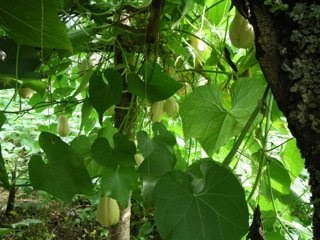Outside of class, I have been invited to a fe
 w farms to learn more about agriculture here in Uganda. The majority of farms are mixed. This allo
w farms to learn more about agriculture here in Uganda. The majority of farms are mixed. This allo ws plants that complement each other to grow together. For example, in the hot Ugandan sun, coffee, b
ws plants that complement each other to grow together. For example, in the hot Ugandan sun, coffee, b eans and other crops would quickly dry out if planted in the open. Instead, they plant these crops within their banana plantations to allow them to grow in partial shade. Most farms also have at least one papaya tree, avocado, mango, passion fruit vine, etc, providing a constant source of fresh fruit.
eans and other crops would quickly dry out if planted in the open. Instead, they plant these crops within their banana plantations to allow them to grow in partial shade. Most farms also have at least one papaya tree, avocado, mango, passion fruit vine, etc, providing a constant source of fresh fruit.There are usually a variety of animals of the farm as well. Cattle may range from 1 to 30 head depending on the size of the land. Most farmers pasture their cattle and some supplement with protein and banana peels to increase milk production from 5 L per day to 20 L per day.
In addition to cows, a farm may have pigs, goats, sheep, guinea hens, bees and chickens. Some of our friends keep several hundred laying hens, although we have yet to visit their farms to see the set up for these hens.
 Bees are also a popular source of income, Although the hives look different than our hive
Bees are also a popular source of income, Although the hives look different than our hive s in Canada, the honey is delicious. All of this may be found on less than 2 acres of land. One farmer we visited also has a small pond on his 2 acres of land where he raises tilapia.
s in Canada, the honey is delicious. All of this may be found on less than 2 acres of land. One farmer we visited also has a small pond on his 2 acres of land where he raises tilapia.The most interesting vegetable we have met here so far is called manetti
 . It is in the squash/cucum
. It is in the squash/cucum ber family, but tastes more like a water chestnut. It is very prickly on the outside, but white and crispy on the inside. We were given two vegetables to try. We ate one. The other one decided to grow before we ate it, so we have planted it next to our fence. We will see how much it grows before we leave.
ber family, but tastes more like a water chestnut. It is very prickly on the outside, but white and crispy on the inside. We were given two vegetables to try. We ate one. The other one decided to grow before we ate it, so we have planted it next to our fence. We will see how much it grows before we leave.

1 comment:
Those manetti sound cool.
Post a Comment